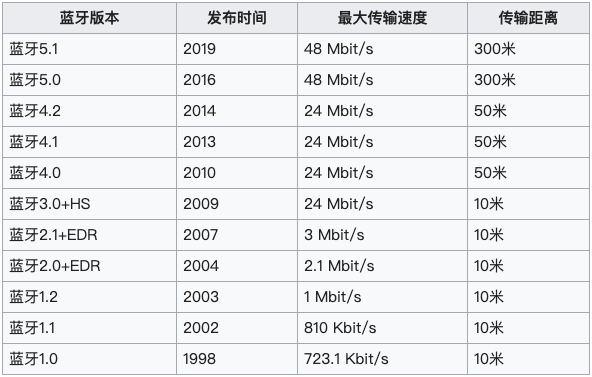概述
蓝牙(英语:Bluetooth),一种无线通讯技术标准,用来让固定与移动设备,在短距离间交换数据,以形成个人局域网(PAN)。蓝牙技术当前由蓝牙技术联盟(SIG)来负责维护其技术标准。
版本

分类
蓝牙可分为经典蓝牙(Classic Bluetooth)、低功耗蓝牙(Bluetooth Low Energy)、双模蓝牙三大类。2009 年发布的蓝牙 3.0 及之前的蓝牙版本包括 BR、EDR 和 HS(AMP) 三种蓝牙技术,统称为经典蓝牙技术,只支持经典蓝牙技术的蓝牙称为经典蓝牙。2010 年 SIG 联盟合并了 Wibree 联盟,并把 Wibree 联盟提出的低功耗无线技术重新命名为低功耗蓝牙技术(BLE)。2010 年发布的蓝牙 4.0 规格就同时包含经典蓝牙和低功耗蓝牙,只支持低功耗蓝牙技术的蓝牙称为低功率蓝牙,同时支持经典蓝牙和低功率蓝牙技术的蓝牙称为双模蓝牙。低功耗蓝牙与经典蓝牙技术是不兼容的,所以低功耗蓝牙和经典蓝牙两者之间是不能相互通信的。
优缺点
经典蓝牙技术持续保持连接,可以传输大数据,适合文件传输、音频播放等,兼容性高,广播信道多,缺点是连接成本高,功耗高;低功耗蓝牙连接速度快,低功耗,广播信道少,缺点是数据传输量有限制。
Android
Android 平台包含蓝牙网络堆栈支持,凭借此项支持,设备能以无线方式与其他蓝牙设备交换数据。应用框架提供了通过 Android Bluetooth API 访问蓝牙功能的途径。针对具有低功耗要求的蓝牙设备,Android 4.3(API 级别 18)中引入了面向低功耗蓝牙的 API 支持。即 SPP 协议(经典蓝牙)和 GATT 协议(低功耗蓝牙)的连接方式。 使用 Android 蓝牙功能需要在 Manifest.xml 文件中声明蓝牙权限,如果使用了蓝牙扫描功能还需要声明位置权限,因为蓝牙是具有定位功能的,目标版本是 Android 23 及以上版本需要添加动态权限申请。
<uses-permission android:name="android.permission.BLUETOOTH" />
<uses-permission android:name="android.permission.BLUETOOTH_ADMIN" />
// 蓝牙扫描需要位置权限
<uses-permission android:name="android.permission.ACCESS_COARSE_LOCATION"/>
SPP 方式
- 启用蓝牙
BluetoothAdapter mBluetoothAdapter = BluetoothAdapter.getDefaultAdapter()
if (!mBluetoothAdapter.isEnabled()) {
Intent enableBtIntent = new Intent(BluetoothAdapter.ACTION_REQUEST_ENABLE);
startActivityForResult(enableBtIntent, REQUEST_ENABLE_BT);
}
- 查询配对的设备
Set<BluetoothDevice> pairedDevices = mBluetoothAdapter.getBondedDevices();
// If there are paired devices
if (pairedDevices.size() > 0) {
// Loop through paired devices
for (BluetoothDevice device : pairedDevices) {
// Add the name and address to an array adapter to show in a ListView
mArrayAdapter.add(device.getName() + "\n" + device.getAddress());
}
}
- 发现设备,这里需要注册 ACTION_FOUND Intent BroadcastReceiver, Intent 携带额外字段 EXTRA_DEVICE 和 EXTRA_CLASS,二者分别包含 BluetoothDevice 和 BluetoothClass,如果没申请位置权限,这里发现不了其他设备。
mBluetoothAdapter.startDiscovery();
// Create a BroadcastReceiver for ACTION_FOUND
private final BroadcastReceiver mReceiver = new BroadcastReceiver() {
public void onReceive(Context context, Intent intent) {
String action = intent.getAction();
// When discovery finds a device
if (BluetoothDevice.ACTION_FOUND.equals(action)) {
// Get the BluetoothDevice object from the Intent
BluetoothDevice device = intent.getParcelableExtra(BluetoothDevice.EXTRA_DEVICE);
// Add the name and address to an array adapter to show in a ListView
mArrayAdapter.add(device.getName() + "\n" + device.getAddress());
}
}
};
// Register the BroadcastReceiver
IntentFilter filter = new IntentFilter(BluetoothDevice.ACTION_FOUND);
registerReceiver(mReceiver, filter); // Don't forget to unregister during onDestroy
- 连接设备,蓝牙连接属于耗时操作,需要放在子线程执行。在蓝牙协议中,UUID 被用来标识蓝牙设备所提供的服务,并非是标识蓝牙设备本身。一个蓝牙设备可以提供多种服务,比如 A2DP(蓝牙音频传输)、HEADFREE(免提)、PBAP(电话本)等,每种服务都对应一个UUID。连接成功后可以获取蓝牙设备的输入输出流,进行数据交互操作。
private class ConnectThread extends Thread {
private final BluetoothSocket mmSocket;
private final BluetoothDevice mmDevice;
private final InputStream mmInStream;
private final OutputStream mmOutStream;
public ConnectThread(BluetoothDevice device) {
// Use a temporary object that is later assigned to mmSocket,
// because mmSocket is final
BluetoothSocket tmp = null;
mmDevice = device;
// Get a BluetoothSocket to connect with the given BluetoothDevice
try {
// MY_UUID is the app's UUID string, also used by the server code
tmp = device.createRfcommSocketToServiceRecord(MY_UUID);
} catch (IOException e) { }
mmSocket = tmp;
}
public void run() {
// Cancel discovery because it will slow down the connection
mBluetoothAdapter.cancelDiscovery();
try {
// Connect the device through the socket. This will block
// until it succeeds or throws an exception
mmSocket.connect();
tmpIn = socket.getInputStream();
tmpOut = socket.getOutputStream();
} catch (IOException connectException) {
// Unable to connect; close the socket and get out
try {
mmSocket.close();
} catch (IOException closeException) { }
return;
}
// Do work to manage the connection (in a separate thread)
manageConnectedSocket(mmSocket);
}
/** Will cancel an in-progress connection, and close the socket */
public void cancel() {
try {
mmSocket.close();
} catch (IOException e) { }
}
}
GATT 方式
- 启用蓝牙和 SPP 方式是一样的
- 发现设备,同样需要在子线程执行,不过通过接收回调的方式获取发现的设备,而不是注册广播。不过需要注意的是发现设备是高功耗行为,需要设置一个超时时间停止扫描。
private ScanCallback mLeScanCallback = new ScanCallback() {
@Override
public void onScanResult(int callbackType, ScanResult result) {
super.onScanResult(callbackType, result);
}
@Override
public void onBatchScanResults(List<ScanResult> results) {
super.onBatchScanResults(results);
}
@Override
public void onScanFailed(int errorCode) {
super.onScanFailed(errorCode);
}
};
mHandler.postDelayed(new Runnable() {
@Override
public void run() {
bluetoothLeScanner.stopScan(mLeScanCallback);
}
}, SCAN_PERIOD);
bluetoothLeScanner.startScan(mLeScanCallback);
- 连接设备,可以在 BluetoothGattCallback 中实现各种回调方法,如发现服务、监听蓝牙数据等。值得注意的一点是连接 API 在 Android version >= 23 时多了一个参数,如果不加上 BluetoothDevice.TRANSPORT_LE 可能导致连接不上 BLE 设备
// Various callback methods defined by the BLE API.
private final BluetoothGattCallback gattCallback =
new BluetoothGattCallback() {
@Override
public void onConnectionStateChange(BluetoothGatt gatt, int status,
int newState) {
String intentAction;
if (newState == BluetoothProfile.STATE_CONNECTED) {
intentAction = ACTION_GATT_CONNECTED;
connectionState = STATE_CONNECTED;
Log.i(TAG, "Connected to GATT server.");
Log.i(TAG, "Attempting to start service discovery:" +
bluetoothGatt.discoverServices());
} else if (newState == BluetoothProfile.STATE_DISCONNECTED) {
intentAction = ACTION_GATT_DISCONNECTED;
connectionState = STATE_DISCONNECTED;
Log.i(TAG, "Disconnected from GATT server.");
}
}
@Override
// New services discovered
public void onServicesDiscovered(BluetoothGatt gatt, int status) {
if (status == BluetoothGatt.GATT_SUCCESS) {
} else {
Log.w(TAG, "onServicesDiscovered received: " + status);
}
}
@Override
// Result of a characteristic read operation
public void onCharacteristicRead(BluetoothGatt gatt,
BluetoothGattCharacteristic characteristic,
int status) {
if (status == BluetoothGatt.GATT_SUCCESS) {
broadcastUpdate(ACTION_DATA_AVAILABLE, characteristic);
}
}
...
};
BluetoothGatt bluetoothGatt;
if (Build.VERSION.SDK_INT >= Build.VERSION_CODES.M) {
bluetoothGatt = device.connectGatt(context, false, mGattCallback, BluetoothDevice.TRANSPORT_LE);
} else {
bluetoothGatt = device.connectGatt(context, false, mGattCallback);
}
总结
其实 Android 蓝牙相关的 API 使用还是比较简单的,对于初次接触蓝牙开发的小白来说,弄清楚蓝牙设备的类型以及连接方式就成功了一半(经典蓝牙 SPP,低功耗蓝牙 GATT)。另外一半在于蓝牙设备的适配及细节的掌握,适配问题可以多联系蓝牙设备供应商的技术支持,细节问题就靠平时积累和多搜索查阅资料了。 最后安利两个 BLE 开源库:RxAndroidBle、flutter_blue。
@123lxw123, 本文版权属于再惠研发团队,欢迎转载,转载请保留出处。